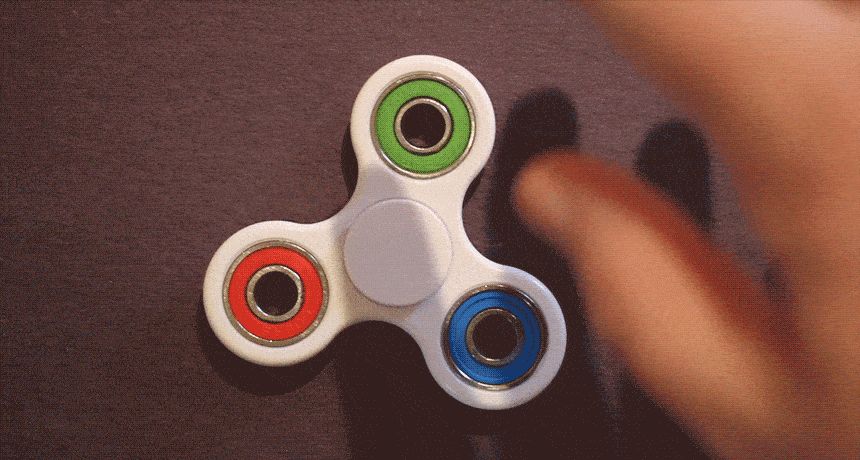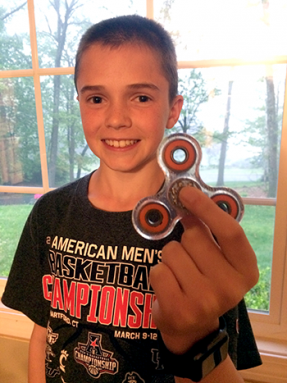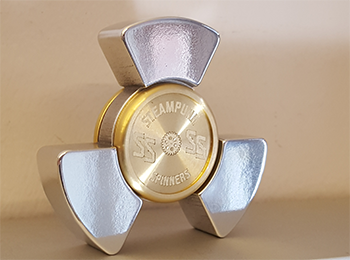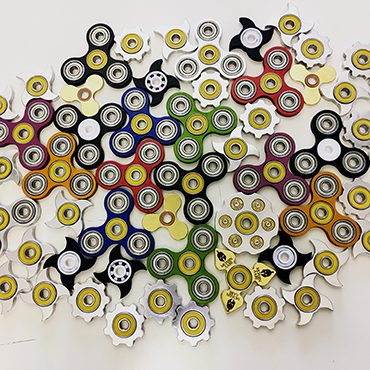Are fidget spinners tools or toys?
The wildly popular gadgets may help some people focus

Fidget spinners are fun and some think they might benefit the brain.
L. S. Hwang
Andrew Bonini was stuck inside at school on a sweltering day. To get his mind off the heat, the eighth grader took out his fidget spinner — a flat, palm-sized gadget with three arms that spins on a ball bearing. The Connecticut teen flicked it and watched it spin around and around. It whirred quietly.

Andrew is 14. His younger sisters each have their own fidget spinners. Twelve-year-old Ava is teaching herself a trick. “I’ll be holding it and spinning it on my pointer finger, then I try to balance it on my middle finger while it’s spinning.” Allie, who’s nine, has been trying to balance hers on her nose as it spins. “It’s not easy,” she notes.
Silly tricks aside, all three siblings feel their spinners are more than mere toys. Andrew thinks the gadget helps him reduce stress and boredom. Allie tends to take hers out when she’s alone in her bedroom and feeling upset or anxious. “If I can play with it for five minutes, it helps me not be as worried,” she says.
The Bonini kids are part of the fidget spinner craze that is sweeping across the United States and other parts of the world. People of all ages are spinning an array of devices that come in all sorts of shapes and colors. The spinners follow a long line of toy fads, from hula hoops to Pokémon cards and silly bands.
But fidget spinners may be more than just a toy. Some websites that sell them have made sweeping health claims. They say the spinners can help relieve stress, anxiety or even the symptoms of attention deficit hyperactivity disorder (ADHD). At the same time, some schools have banned the gadgets for being too distracting. So, are spinners annoying toys or therapeutic tools? It turns out, they can be both.
Story continues below video.
Spinner inspiration
Years before the current spinner craze took off, inventor Catherine Hettinger of Winter Park, Fla., was going through a difficult summer. She has a disorder called myasthenia gravis. In this condition, instructions from the brain can fail to make it to the muscles. People like Hettinger can therefore have trouble moving their arms and hands. Her daughter, Sara, was seven at the time. “I couldn’t pick up my daughter’s toys and couldn’t play with her,” the woman recalls.
Whenever Hettinger hears of a problem, though, no matter how large or small, she immediately starts imagining devices to fix it. She and her daughter worked together to design and build something they could play with together. “We toyed with all kinds of kitchen stuff and other household objects. I could crumple up newspaper and use tape to think in three dimensions,” she says.

The result of all that tinkering was a small plastic disc that could be spun on the tip of a finger. In 1993, Hettinger filed for a patent on the spinning toy and started selling it at craft fairs. (A patent gives a person or company exclusive rights to make, sell or use an invention.) She also pitched the device to toy companies. Before a meeting with the vice president and lead designer of one company, Hettinger found herself playing with the spinner. She says, “It helped to calm me down.”
Unfortunately, none of the companies decided to produce her toy. And a patent doesn’t last forever. Hettinger eventually let hers lapse. Though she continued to sell the spinners at craft fairs and online, the idea of a finger spinner no longer belonged to her alone. Yet she’s thrilled that a variation on her idea has now become so popular.
The fidget spinners that most people have now don’t look much like Hettinger’s original. Hers looked a bit like a sun hat or a flying saucer that would balance atop a fingertip. Most of today’s spinners have three arms and spin for a longer time on tiny ball bearings. People have gotten very creative with new sizes and shapes for these spinners.
Since last fall, for instance, Joe Garritano has been making spinners in his garage. “It looks like a mad scientist’s laboratory,” he quips. Some of his hand-made all-metal spinners sell for more than $100. Most of his customers are collectors who view the spinners as works of art. Others buy them for a very different reason: therapy.
Story continues below video.
Fidget to focus
Garritano’s high-end collectibles, Hettinger’s classic spinner and the Boninis’ three-spoked fidget spinner are all part of a much broader category of toys that therapists sometimes use as tools for their patients. There are balls to squish, putty to stretch, smooth stones to rub, necklaces or bracelets to chew on and a multitude of other objects. Therapists refer to these items as “sensory manipulatives” or “fidgets.” The patient uses the fidget to excite one or more senses. This typically helps them either to calm down or become more alert.

“Fidget tools provide us with subtle movement and touch inputs that can help calm our bodies and keep our minds attentive, alert and focused,” says Claire Heffron. She is an occupational therapist in Cleveland, Ohio. (An occupational therapist helps a person with a disorder or disability learn to perform daily tasks.)
Garritano estimates that two or three in every 10 of his customers bought their fidget spinners to help combat stress or anxiety or to improve focus. “The entire executive officer crew on a navy warship has them,” he says. They were a gift from their senior officer.
Varleisha Gibbs has recommended fidgets for therapy many times. She is an occupational therapist at Wesley College in Dover, Del. One student she worked with was constantly moving and touching things on other kids’ desks. She suggested a stress ball. “We Velcroed it underneath the desk,” she says. This helped the student keep his body in his own space. “He could get what he was seeking through touch, without being a distraction.”
Clearly, fidget devices are nothing new, notes Julie Schweitzer. She is a scientist at the University of California, Davis. A psychologist, she studies ways to diagnose and treat ADHD. People with this disorder have trouble paying attention and often move constantly or act impulsively. In some kids with this disorder, she explains, moving or fidgeting seems to increase their ability to pay attention.
Schweitzer tested this in a study published in 2015. Her team recruited 44 kids between the ages of 10 and 17. Twenty-six of the volunteers had ADHD. The others had no diagnosed disorders. They served as a control group. All of the kids completed an attention task. Each sat at a computer and viewed rows of arrows. In each row, they had to quickly identify which way the central arrow was pointing. Meanwhile, the kids all wore a device on their ankles. It tracked their motion.
The researchers didn’t ask the kids to move or to stay still. The kids simply knew they were to complete the task. For those with ADHD, the more they moved, the better they performed. But the amount of movement didn’t make a difference for the control group.
The study didn’t explain why movement helps kids with ADHD focus. But Schweitzer suspects that it’s similar to rubbing your face to wake up when you’re feeling tired. “I think the movement makes them more alert,” she says. As their attention starts to drift, a leg jiggle or foot tap seems to help rein them back in.
Getting distracted
Both Gibbs and Schweitzer agree that fidget spinners could help some kids with specific sensory needs. But a fidget spinner isn’t a magic cure. “It’s not for everyone,” says Gibbs.
Moreover, Schweitzer worries that the spinners may make it more difficult for some kids to focus. Students with ADHD get distracted very easily, she says. If other kids have spinners out at their desks at school, the student with ADHD will likely be watching the spinner and not the teacher.
Someone’s own spinner may distract as well, especially if it’s new. Kids may impulsively stop their work to spin it. They may use the spinner as a way to tune out the lesson. “You put a bright shiny toy in front of somebody” and what would you expect, asks Schweitzer? “Would they rather do that or read a history assignment?”
Fidget spinners regularly distract kids without ADHD as well. That can explain what’s behind recent school classroom bans on the devices.

In effective fidget therapy, the tool is integrated into students’ daily routines. It’s an activity someone practices until they don’t think about it anymore. A therapist with special training can help people discover what type of fidget tool might best meet their specific needs, says Gibbs. That tool, though, will be just one small part of a larger treatment plan that may include medication and other forms of therapy.
And a fidget spinner may not be the right choice for many kids with ADHD or other disorders that affect the senses. The spinner provides mainly visual feedback and only requires the movement of a few fingers. That may be fun or even relaxing. Still, what a child often may really need is the opportunity to stand, stretch or take a walk, explains Schweitzer.
Gibbs recommends wall push-ups and yoga poses. She also laments the fact that many schools have cut the amount of time kids spend at recess or in gym classes. Andrew Bonini, for instance, only has gym two out of every six school days.
Movement may be essential for many children with sensory disorders, but it’s important for everyone. Fidget spinners may help relieve some squirminess, but they won’t take the place of real exercise. “Kids are meant to move and to experience the world around them using their senses,” says Heffron in Ohio. She argues that “the more we can build opportunities for movement and sensory input into their school day, the better.”







